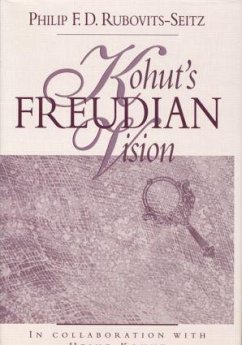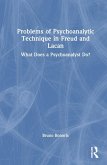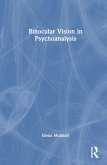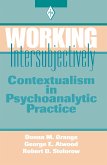Philip F D Rubovits-Seitz
Kohut's Freudian Vision
Philip F D Rubovits-Seitz
Kohut's Freudian Vision
- Gebundenes Buch
- Merkliste
- Auf die Merkliste
- Bewerten Bewerten
- Teilen
- Produkt teilen
- Produkterinnerung
- Produkterinnerung
Rubovits-Seitz continues with his own insightful analysis of Kohut's distinctive approach to Freudian theory. And he concludes by arguing persuasively why Kohut's later contributions should best be viewed as a continuation, rather than an abandonment, of
Andere Kunden interessierten sich auch für
![Problems of Psychoanalytic Technique in Freud and Lacan Problems of Psychoanalytic Technique in Freud and Lacan]() Bruno BonorisProblems of Psychoanalytic Technique in Freud and Lacan193,99 €
Bruno BonorisProblems of Psychoanalytic Technique in Freud and Lacan193,99 €![Binocular Vision Binocular Vision]() Elena MolinariBinocular Vision193,99 €
Elena MolinariBinocular Vision193,99 €![Radical Claims in Freudian Psychoanalysis Radical Claims in Freudian Psychoanalysis]() M Andrew HolowchakRadical Claims in Freudian Psychoanalysis157,99 €
M Andrew HolowchakRadical Claims in Freudian Psychoanalysis157,99 €![Who Is the Dreamer, Who Dreams the Dream? Who Is the Dreamer, Who Dreams the Dream?]() James S GrotsteinWho Is the Dreamer, Who Dreams the Dream?129,99 €
James S GrotsteinWho Is the Dreamer, Who Dreams the Dream?129,99 €![Working Intersubjectively Working Intersubjectively]() Donna M OrangeWorking Intersubjectively189,99 €
Donna M OrangeWorking Intersubjectively189,99 €![The Christopher Bollas Reader The Christopher Bollas Reader]() Christopher BollasThe Christopher Bollas Reader189,99 €
Christopher BollasThe Christopher Bollas Reader189,99 €![Seduction, Surrender, and Transformation Seduction, Surrender, and Transformation]() Karen J MarodaSeduction, Surrender, and Transformation191,99 €
Karen J MarodaSeduction, Surrender, and Transformation191,99 €-
-
-
Rubovits-Seitz continues with his own insightful analysis of Kohut's distinctive approach to Freudian theory. And he concludes by arguing persuasively why Kohut's later contributions should best be viewed as a continuation, rather than an abandonment, of
Hinweis: Dieser Artikel kann nur an eine deutsche Lieferadresse ausgeliefert werden.
Hinweis: Dieser Artikel kann nur an eine deutsche Lieferadresse ausgeliefert werden.
Produktdetails
- Produktdetails
- Verlag: Taylor & Francis
- Seitenzahl: 256
- Erscheinungstermin: 1. Mai 1999
- Englisch
- Abmessung: 235mm x 161mm x 24mm
- Gewicht: 517g
- ISBN-13: 9780881632842
- ISBN-10: 0881632848
- Artikelnr.: 21568634
- Herstellerkennzeichnung
- Libri GmbH
- Europaallee 1
- 36244 Bad Hersfeld
- gpsr@libri.de
- Verlag: Taylor & Francis
- Seitenzahl: 256
- Erscheinungstermin: 1. Mai 1999
- Englisch
- Abmessung: 235mm x 161mm x 24mm
- Gewicht: 517g
- ISBN-13: 9780881632842
- ISBN-10: 0881632848
- Artikelnr.: 21568634
- Herstellerkennzeichnung
- Libri GmbH
- Europaallee 1
- 36244 Bad Hersfeld
- gpsr@libri.de
Philip F. D. Rubovits-Seitz, M.D., is Clinical Professor of Psychiatry, George Washington University Medical Center, and Member of the Washington Psychoanalytic Society and Institute. He was previously Director of Psychiatric Research, Indiana University; Visiting Professor of Psychiatry, University of Cincinatti; and Staff Member, The Chicago Institute for Psychoanalysis. He has received a number of national and other awards for research and teaching.
Part I: Kohut's Lectures on Psychoanalytic Psychology (1958-1960). Three
Periods in the Development of Psychoanalysis. How It All Began. The Dynamic
and Topographic Points of View. Conflict, Transference, and Infantile
Sexuality.Optimal versus Traumatic Frustration, Memory versus
Hallucinations, and Daydreaming. Psychic Trauma and the Economic Point of
View. Primal Repression and "Actual Neurosis." The Genetic Point of View.
Symptom Formation. Symptom Formation From a Longitudinal Perspective.
Freud's Theory of Psychosis. Freud's Theory of Depression and Preoedipal
Phobias. Chapter 7 in The Interpretation of Dreams. Chapter 7, Section A:
The Forgetting of Dreams. Chapter 7, Section B: Regression. Chapter 7,
Section B: Regression (continued). Chapter 7, Section C: Wish-Fulfillment.
Chapter 7, Section C: Wish-Fulfillment (continued). Chapter 7, Section D:
The Function of Dreams. Chapter 7, Section D: The Function of Dreams
(continued). Chapter 7, Section E: Primary and Secondary Process. Chapter
7, Section F: The Unconscious, Consciousness, and Reality. The Second Phase
in the Development of Psychoanalytic Theory. Melancholia. The Structural
Model and Neutralization. Aggression. Aggression (continued): The
"Childhood Object" and the Superego. The Ego Ideal: Censuring and Approving
Parts of the Superego. Narcissism. The Dual Instinct Theory. Changes in the
Concept of Anxiety. Inhibitions, Symptoms and Anxiety: Chapters 1 and 2.
Inhibitions, Symptoms and Anxiety: Chapters 3 and 4. Inhibitions, Symptoms
and Anxiety: Chapter 5. Part II: Concepts and Theories of Psychoanalysis
(1963). Part III: Kohut's Method of Synthesizing Freudian Theory. Part IV:
Kohut's Concepts of Narcissism and Self Psychology: Continuities with
Freudian Theory.
Periods in the Development of Psychoanalysis. How It All Began. The Dynamic
and Topographic Points of View. Conflict, Transference, and Infantile
Sexuality.Optimal versus Traumatic Frustration, Memory versus
Hallucinations, and Daydreaming. Psychic Trauma and the Economic Point of
View. Primal Repression and "Actual Neurosis." The Genetic Point of View.
Symptom Formation. Symptom Formation From a Longitudinal Perspective.
Freud's Theory of Psychosis. Freud's Theory of Depression and Preoedipal
Phobias. Chapter 7 in The Interpretation of Dreams. Chapter 7, Section A:
The Forgetting of Dreams. Chapter 7, Section B: Regression. Chapter 7,
Section B: Regression (continued). Chapter 7, Section C: Wish-Fulfillment.
Chapter 7, Section C: Wish-Fulfillment (continued). Chapter 7, Section D:
The Function of Dreams. Chapter 7, Section D: The Function of Dreams
(continued). Chapter 7, Section E: Primary and Secondary Process. Chapter
7, Section F: The Unconscious, Consciousness, and Reality. The Second Phase
in the Development of Psychoanalytic Theory. Melancholia. The Structural
Model and Neutralization. Aggression. Aggression (continued): The
"Childhood Object" and the Superego. The Ego Ideal: Censuring and Approving
Parts of the Superego. Narcissism. The Dual Instinct Theory. Changes in the
Concept of Anxiety. Inhibitions, Symptoms and Anxiety: Chapters 1 and 2.
Inhibitions, Symptoms and Anxiety: Chapters 3 and 4. Inhibitions, Symptoms
and Anxiety: Chapter 5. Part II: Concepts and Theories of Psychoanalysis
(1963). Part III: Kohut's Method of Synthesizing Freudian Theory. Part IV:
Kohut's Concepts of Narcissism and Self Psychology: Continuities with
Freudian Theory.
Part I: Kohut's Lectures on Psychoanalytic Psychology (1958-1960). Three
Periods in the Development of Psychoanalysis. How It All Began. The Dynamic
and Topographic Points of View. Conflict, Transference, and Infantile
Sexuality.Optimal versus Traumatic Frustration, Memory versus
Hallucinations, and Daydreaming. Psychic Trauma and the Economic Point of
View. Primal Repression and "Actual Neurosis." The Genetic Point of View.
Symptom Formation. Symptom Formation From a Longitudinal Perspective.
Freud's Theory of Psychosis. Freud's Theory of Depression and Preoedipal
Phobias. Chapter 7 in The Interpretation of Dreams. Chapter 7, Section A:
The Forgetting of Dreams. Chapter 7, Section B: Regression. Chapter 7,
Section B: Regression (continued). Chapter 7, Section C: Wish-Fulfillment.
Chapter 7, Section C: Wish-Fulfillment (continued). Chapter 7, Section D:
The Function of Dreams. Chapter 7, Section D: The Function of Dreams
(continued). Chapter 7, Section E: Primary and Secondary Process. Chapter
7, Section F: The Unconscious, Consciousness, and Reality. The Second Phase
in the Development of Psychoanalytic Theory. Melancholia. The Structural
Model and Neutralization. Aggression. Aggression (continued): The
"Childhood Object" and the Superego. The Ego Ideal: Censuring and Approving
Parts of the Superego. Narcissism. The Dual Instinct Theory. Changes in the
Concept of Anxiety. Inhibitions, Symptoms and Anxiety: Chapters 1 and 2.
Inhibitions, Symptoms and Anxiety: Chapters 3 and 4. Inhibitions, Symptoms
and Anxiety: Chapter 5. Part II: Concepts and Theories of Psychoanalysis
(1963). Part III: Kohut's Method of Synthesizing Freudian Theory. Part IV:
Kohut's Concepts of Narcissism and Self Psychology: Continuities with
Freudian Theory.
Periods in the Development of Psychoanalysis. How It All Began. The Dynamic
and Topographic Points of View. Conflict, Transference, and Infantile
Sexuality.Optimal versus Traumatic Frustration, Memory versus
Hallucinations, and Daydreaming. Psychic Trauma and the Economic Point of
View. Primal Repression and "Actual Neurosis." The Genetic Point of View.
Symptom Formation. Symptom Formation From a Longitudinal Perspective.
Freud's Theory of Psychosis. Freud's Theory of Depression and Preoedipal
Phobias. Chapter 7 in The Interpretation of Dreams. Chapter 7, Section A:
The Forgetting of Dreams. Chapter 7, Section B: Regression. Chapter 7,
Section B: Regression (continued). Chapter 7, Section C: Wish-Fulfillment.
Chapter 7, Section C: Wish-Fulfillment (continued). Chapter 7, Section D:
The Function of Dreams. Chapter 7, Section D: The Function of Dreams
(continued). Chapter 7, Section E: Primary and Secondary Process. Chapter
7, Section F: The Unconscious, Consciousness, and Reality. The Second Phase
in the Development of Psychoanalytic Theory. Melancholia. The Structural
Model and Neutralization. Aggression. Aggression (continued): The
"Childhood Object" and the Superego. The Ego Ideal: Censuring and Approving
Parts of the Superego. Narcissism. The Dual Instinct Theory. Changes in the
Concept of Anxiety. Inhibitions, Symptoms and Anxiety: Chapters 1 and 2.
Inhibitions, Symptoms and Anxiety: Chapters 3 and 4. Inhibitions, Symptoms
and Anxiety: Chapter 5. Part II: Concepts and Theories of Psychoanalysis
(1963). Part III: Kohut's Method of Synthesizing Freudian Theory. Part IV:
Kohut's Concepts of Narcissism and Self Psychology: Continuities with
Freudian Theory.








